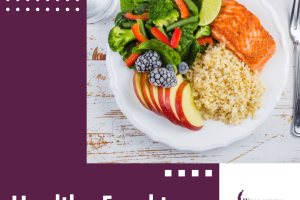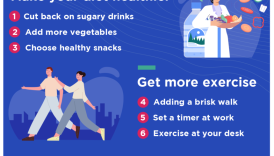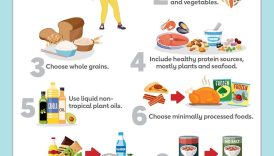Fuel Your Body Right with These Healthy Living Menu Tips

Importance of Healthy Eating
In today’s fast-paced world, the importance of healthy eating cannot be overstated. It’s not just about maintaining a slim figure; it’s about fueling our bodies with the nutrients they deserve. Reflecting on my own journey, I’ve noticed how better food choices have greatly enhanced my energy levels and overall mood. Healthy eating:
- Fuel Your Body Right with These Healthy Living Menu Tips
- Importance of Healthy Eating
- Include a Variety of Fruits and Vegetables
- Benefits of Colorful Produce
- Choose Lean Protein Sources
- Importance of Protein for Body
- Incorporate Whole Grains
- Types of Whole Grains
- Limit Added Sugars and Saturated Fats
- Health Risks of Excess Sugar and Saturated Fats
- Stay Hydrated with Water
- Benefits of Drinking Water
- Portion Control and Balanced Meals
- Tips for Portion Control
- Prepare Meals with Healthy Cooking Methods
- Healthier Alternatives to Frying
- Mindful Eating and Enjoying Your Meals
- Benefits of Mindful Eating
- Meal Planning and Grocery Shopping Tips
- How to Plan Healthy Meals
- Healthy Snack Options
- Snack Ideas for Energy and Nutrition
- XII. Dining Out the Healthy Way
- Making Smart Choices When Eating Out
- XIII. Listen to Your Body and Honor Your Hunger Cues
- Signs of Hunger and Fullness
- XIV. Seek Professional Advice if Needed
- Consulting a Registered Dietitian
- XV. Conclusion
- Recap of Healthy Living Menu Tips
- Supports heart health
- Boosts immune function
- Enhances mental clarity
When we prioritize nourishing foods, we pave the way for a vibrant, energetic life. By making simple changes—like swapping out processed snacks for fruits and nuts—we can significantly improve our well-being and longevity. It’s time to embrace healthy eating not just as a trend, but as a way of life!
Include a Variety of Fruits and Vegetables
Benefits of Colorful Produce
Continuing our journey toward healthier eating, let’s dive into the magical world of fruits and vegetables. Incorporating a wide array of colorful produce not only adds visual appeal to our meals but also packs a powerful nutritional punch. Consider this:
- Red (tomatoes, strawberries) boosts heart health.
- Green (spinach, broccoli) strengthens bones.
- Yellow/Orange (carrots, peppers) enhances immune function.
- Purple (eggplants, blueberries) supports brain health.
I always aim for a rainbow on my plate, which not only makes me feel good but also keeps my body energized and vibrant. By embracing diverse fruits and vegetables, we ensure our bodies receive a rich variety of vitamins, minerals, and antioxidants essential for optimal health.
Choose Lean Protein Sources
Importance of Protein for Body
As we continue exploring the building blocks of a nutritious diet, let’s talk about protein. Choosing lean protein sources plays a vital role in maintaining our overall health. Protein is essential for repairing tissues, building muscles, and even producing hormones. Some of my favorite lean proteins include:
- Chicken breast
- Turkey
- Fish (like salmon and tuna)
- Legumes (beans and lentils)
- Tofu or tempeh for plant-based options
Incorporating these proteins into meals not only keeps you feeling full longer but also supports weight management and muscle health. By focusing on lean options, we can enjoy the benefits of protein without excess fats, making it a win-win for our bodies!
Incorporate Whole Grains
Types of Whole Grains
Moving on from the importance of lean proteins, let’s focus on another crucial component of a balanced diet: whole grains. Incorporating whole grains not only elevates the nutritional value of meals but also provides sustained energy throughout the day. Here are some delicious whole grains to consider:
- Quinoa: A complete protein source packed with essential amino acids.
- Brown rice: A fiber-rich alternative to white rice.
- Oats: Perfect for a hearty breakfast and great for heart health.
- Barley: Ideal for soups and stews, offering a unique texture and flavor.
- Whole wheat bread: A staple for sandwiches that keeps you full longer.
I love starting my day with overnight oats topped with fruits, which keeps me energized for hours. By choosing whole grains, we provide our bodies with essential nutrients that promote digestive health and reduce the risk of chronic diseases. It’s a simple switch that makes a significant impact!
Limit Added Sugars and Saturated Fats
Health Risks of Excess Sugar and Saturated Fats
Now that we’ve covered the benefits of whole grains, it’s essential to address the need to limit added sugars and saturated fats in our meals. These ingredients may add flavor but can significantly impact our health when consumed in excess. The health risks include:
- Weight Gain: Excess sugar and saturated fats can lead to obesity.
- Heart Disease: High intake is linked to increased cholesterol levels.
- Diabetes: Added sugars can lead to insulin resistance over time.
In my own experience, cutting back on sugary drinks and processed snacks transformed my energy levels and overall well-being. By being mindful of our choices, we can enjoy delicious meals without compromising our health. Aim for balance, and substitute with healthier options like fresh fruit or avocado for added flavor without the risks!
Stay Hydrated with Water
Benefits of Drinking Water
Transitioning from the importance of limiting sugars and fats, let’s talk about staying hydrated—an often overlooked aspect of healthy eating. Drinking enough water is crucial for maintaining our body’s balance and overall health. The benefits of drinking water include:
- Improved Digestion: Water aids in breaking down food and prevents constipation.
- Enhanced Energy Levels: Dehydration can lead to fatigue; staying hydrated keeps energy up.
- Better Skin Health: Hydration helps to maintain skin elasticity and reduce dryness.
I’ve found that keeping a water bottle with me throughout the day encourages me to drink more. It’s a simple habit that contributes to my vitality and focus. Aim for at least 8 glasses of water daily, and your body will thank you!
Portion Control and Balanced Meals
Tips for Portion Control
As we move forward from discussing hydration, let’s shine a light on portion control—a vital element in achieving balanced meals. It’s easy to overlook how much we’re eating, especially with large servings often served at restaurants or gatherings. Here are some practical tips for portion control:
- Use Smaller Plates: This can trick your brain into feeling satisfied with less food.
- Measure Your Portions: For grains and protein, use measuring cups to keep portions in check.
- Listen to Your Body: Pay attention to hunger cues and eat until you’re comfortably full, not stuffed.
In my experience, practicing mindful eating has made a significant difference. By being aware of portion sizes, I enjoy my meals more and maintain a healthier weight. Remember, it’s about quality over quantity when creating balanced and satisfying dishes!
Prepare Meals with Healthy Cooking Methods
Healthier Alternatives to Frying
Following our discussion on portion control, let’s explore healthy cooking methods that enhance the nutritional value of our meals. While frying might be a popular choice for its crispy texture, it often adds unnecessary fats and calories. Thankfully, there are plenty of healthier alternatives to consider! Some great cooking methods include:
- Baking: Perfect for retaining flavors without excess oil. Try baking vegetables or lean proteins for a delicious meal.
- Steaming: This method preserves nutrients and adds moisture. I love steaming broccoli and carrots for a quick side dish!
- Grilling: Adds a smoky flavor without excess calories, perfect for meats and veggies.
- Sautéing: Use a small amount of healthy oil, like olive oil, for flavor while keeping it light.
These methods not only provide healthier options but also allow for creativity in the kitchen. Embracing these techniques has transformed my meals, making them tastier and better for my health. Enjoy experimenting with these cooking styles to enhance your nutritious journey!
Mindful Eating and Enjoying Your Meals
Benefits of Mindful Eating
As we move from healthy cooking methods to enjoying our meals, the practice of mindful eating deserves special attention. This approach not only enhances our dining experience but also fosters a healthier relationship with food. The benefits of mindful eating include:
- Increased Awareness: By focusing on the flavors, textures, and aromas, we savor our meals more fully.
- Better Digestion: Eating slowly gives our body time to process food and signals when we’re full.
- Reduced Overeating: Paying attention helps prevent those “mindless bites” that can lead to excess calorie intake.
Personally, I’ve found that taking time to appreciate my food—putting my phone away and enjoying each bite—has made me feel more satisfied. Incorporating mindfulness into meals encourages a respectful and enjoyable approach to eating, transforming meals into moments of genuine pleasure. Try dedicating mealtime to awareness, and witness the difference it makes!
Meal Planning and Grocery Shopping Tips
How to Plan Healthy Meals
Building on the concept of mindful eating, effective meal planning is essential for ensuring we always have healthy options on hand. A little preparation can save us from resorting to unhealthy choices when hunger strikes. Here are some tips for planning healthy meals:
- Set a Weekly Menu: Dedicate time each week to plan meals, focusing on incorporating a variety of fruits, vegetables, and whole grains.
- Make a Grocery List: Once you have a menu, create a detailed list to avoid impulse buys. Stick to the perimeter of the store where fresh foods are usually located!
- Batch Cook: Prepare larger portions of nutritious meals and store them in the fridge or freezer. This made a significant difference for me during busy weeks—having healthy options ready to go is a game-changer.
By planning ahead, I’ve found it much easier to maintain a balanced diet, allowing me to enjoy nutritious meals without the last-minute scramble. Give meal planning a try, and enjoy the peace of mind it provides!
Healthy Snack Options
Snack Ideas for Energy and Nutrition
Continuing our journey to healthy eating, let’s not overlook the significance of snacking. Choosing the right snacks can fuel your energy levels throughout the day and keep hunger at bay, helping you stay on track with your nutrition goals. Here are some of my favorite healthy snack ideas:
- Greek Yogurt with Berries: Packed with protein and antioxidants, it’s a delicious way to satisfy your sweet tooth.
- Hummus and Veggies: A crunchy, colorful option that provides fiber and healthy fats.
- Nuts and Seeds: A handful can give you a boost of energy and keep you full longer—just watch the portion sizes!
- Whole Grain Crackers with Avocado: Creamy and satisfying, this combo is both nutritious and filling.
By prepping these snacks ahead of time, I’ve managed to curb cravings and maintain energy levels throughout my busy days. Treat snacking as an opportunity to nourish your body, and watch how it positively impacts your health and well-being!
XII. Dining Out the Healthy Way
Making Smart Choices When Eating Out
As we wrap up our conversation about healthy snacks, it’s essential to address how to maintain that momentum when dining out. Restaurants can be tricky places for anyone trying to eat healthily, but with a few smart strategies, you can enjoy eating out without derailing your nutrition goals. Here are some tips for making healthier choices:
- Review the Menu in Advance: This allows you to select options that fit your dietary preferences before arriving.
- Opt for Grilled or Baked Foods: These cooking methods typically use less oil and fat than frying.
- Portion Awareness: Don’t hesitate to ask for a takeout box right away to portion out excess food.
- Choose Veggie-Heavy Dishes: Salads or vegetable-based entrees can be filling and full of nutrients.
During a recent outing, I discovered that ordering a small appetizer as my main dish allowed me to savor the experience without overeating. By being mindful and informed, dining out can be both enjoyable and healthy!
XIII. Listen to Your Body and Honor Your Hunger Cues
Signs of Hunger and Fullness
Continuing from our tips for dining out healthily, an essential part of maintaining a balanced diet is learning to listen to your body. Honoring your hunger cues and recognizing signs of fullness can transform the way you approach food. Here are some signs to pay attention to:
- Hunger Signals: Growling stomach, low energy, or difficulty concentrating can indicate it’s time to eat.
- Fullness Indicators: Feeling satisfied, reduced desire to eat, or a gentle sense of fullness means you may be done.
I remember when I started stopping halfway through meals to assess my hunger. This simple habit helped me avoid overeating and truly enjoy my food. By tuning into these cues, we foster a healthy relationship with food that respects both our body and our appetite. Try it out—your body will thank you!
XIV. Seek Professional Advice if Needed
Consulting a Registered Dietitian
As we wrap up our discussion on listening to our body’s cues, it’s essential to acknowledge that sometimes, seeking professional guidance is the best route to take on your health journey. Consulting a registered dietitian can be particularly beneficial, especially for those with specific dietary needs or goals. Here are a few reasons to consider working with a dietitian:
- Personalized Nutrition Plans: They create tailored meal plans that fit your lifestyle, preferences, and health goals.
- Expert Guidance: Dietitians provide science-backed advice, helping you understand food choices and their effects on your body.
- Support and Accountability: Regular check-ins can motivate you to stay on track with your nutrition journey.
I remember consulting a dietitian when I noticed some digestive issues. Their expertise was invaluable in creating a plan that worked for me. If you’re feeling uncertain about your nutrition, don’t hesitate to reach out to a professional. They can help illuminate the path to your healthiest self!
XV. Conclusion
Recap of Healthy Living Menu Tips
As we conclude our exploration of healthy living menu tips, it’s important to remember that the journey to a healthier lifestyle is a gradual process. By adopting small, manageable changes, you can significantly impact your well-being. To recap, here are the key points we covered:
- Incorporate a Variety of Fruits and Vegetables: Aim for a rainbow on your plate to boost your nutrient intake.
- Choose Lean Protein Sources: Focus on grilled, baked, or steamed options for optimal health benefits.
- Opt for Whole Grains: They provide more fiber and nutrients than refined grains.
- Practice Portion Control: Be mindful of serving sizes to prevent overeating.
- Stay Hydrated: Water is essential for overall health.
Reflecting on my own journey, embracing these tips has transformed the way I approach food and nutrition. Remember, every small step counts, and focusing on balanced, nourishing choices will lead you toward a healthier, happier life. Let’s make healthy living a delightful and rewarding adventure!




